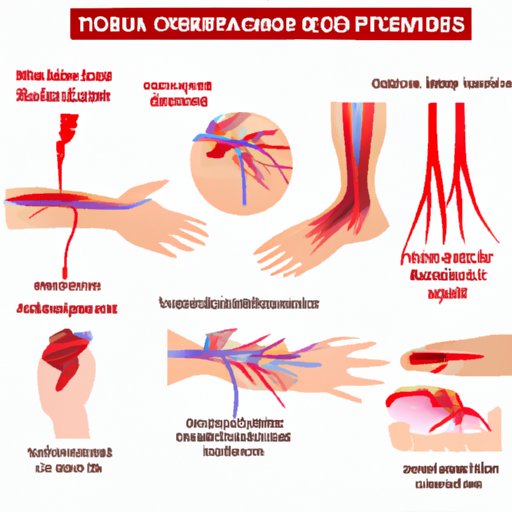
I. Introduction
Blood clots in lungs are considered one of the most severe health conditions a person can experience because they can be deadly. They arise when a clot formed in another part of the body, usually the legs, breaks off and then travels to the lungs. In this article, we examine how to get blood clots in the lungs, the symptoms, prevention, and treatment options available
II. Causes of Blood Clots in Lungs
Many factors can cause blood clots in lungs, including genetic factors, lifestyle habits, and certain underlying medical conditions. Specific examples are:
A. Genetic Factors
Having a family history of blood clots or having a blood-clotting disorder can increase the risk of developing blood clots in the lungs.
B. Lifestyle Habits
Lifestyle choices such as smoking, a sedentary lifestyle, and being overweight or obese increase the likelihood of developing a blood clot.
C. Medical Conditions
Several medical situations that can heighten the risk of blood clots in lungs, such as cancer, heart disease, and inflammatory bowel issues
III. Symptoms and Diagnosis of Pulmonary Embolism
A. Signs and Symptoms
The most common symptom of pulmonary embolism is a sharp pain in the chest. Other signs and symptoms include shortness of breath, coughing up blood, excessive sweating, an increased heart rate, and low blood pressure.
B. Diagnosis process
Doctors may suggest blood tests, imaging tests, and other diagnostic procedures to determine if you have a pulmonary embolism.
IV. Prevention of Blood Clots in the Lungs
A. Lifestyle Modifications
Various lifestyle changes can help reduce the risk of blood clots in lungs, such as exercising regularly, maintaining healthy body weight, and avoiding smoking. Practicing healthy living habits is essential for preventing pulmonary embolisms
B. Medications
Doctors can prescribe blood-thinning medications to help reduce the risk of blood clots
V. Treatment Options for Pulmonary Embolism
A. Anticoagulant Medications
Anticoagulant medications such as heparin and warfarin are prescribed to those who have blood clots in lungs or are at an increased risk of developing them.
B. Surgical Interventions
In more severe cases, surgical interventions such as thrombectomy or placement of a vena cava filter may be used in treating pulmonary embolisms.
VI. Understanding Deep Vein Thrombosis
A. Causes
Deep vein thrombosis (DVT) is a medical condition that can lead to blood clots in your lungs. It is caused by blood clots forming in the deep veins of your legs. In rare cases, DVT occurs due to other factors such as injury or surgery.
B. Symptoms
Swelling, pain, and redness in the legs are typical symptoms of DVT
C. Treatment options
Similar to pulmonary embolism, medication and surgical interventions can help address DVT to prevent the formation of blood clots that could travel to the lungs
VII. Coping with Pulmonary Embolism
A. Strategies for managing the impact on physical health
Coping with pulmonary embolism often involves physical therapy for improved breathing and overall physical health. Engaging in activities that support the physical body can help aid the healing process.
B. Strategies for managing the impact on mental health
Unforeseeably, developing and living with pulmonary embolisms may cause a range of negative emotions. It is important to take steps to safeguard one’s mental health. Engaging in a support group or seeking the help of a mental health professional can be beneficial.
VIII. Risk Factors for Blood Clots in Lungs
Several factors can cause blood clots in lungs, some of which include:
A. Age
As one grows older, your risk of developing a blood clot increases
B. Obesity
Being overweight or obese increase the likelihood of developing blood clots.
C. Smoking
Smoking tobacco products escalate the risk of blood clot formation
D. Pregnancy
Pregnancy increases the risk of blood clots due to hormonal changes and increased pressure on the veins.
E. Certain medical conditions
People living with various medical conditions may increase their risk of blood clotting, such as cancer, heart disease, and autoimmune diseases, among others.
IX. Conclusion
of the Article’s Contents
Developing blood clots in the lung is a serious and life-threatening health condition that should get immediate medical attention. It’s essential to understand the risk factors, the symptoms of pulmonary embolism, and the available diagnostic and treatment options to stay healthy.
B. Final Thoughts on Taking Steps to Prevent Blood Clots in Lungs.
Practicing a healthy lifestyle, quitting smoking, and seeking medical care to ensure your well-being could prevent the formation of blood clots in the lungs altogether. Remember to seek medical attention if you experience any of the symptoms of pulmonary embolism or deep vein thrombosis.




